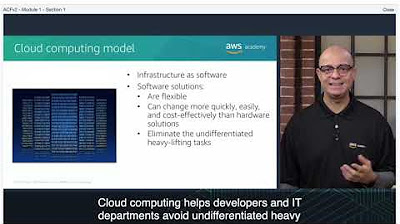CLOUD COMPUTING | CLOUD TECHNOLOGY
Summary
TLDRThis video discusses the concept of cloud computing, explaining its various models and services such as Software as a Service (SaaS), Utility Computing, and Hybrid Cloud. The presenter covers key topics like cloud architecture, the benefits of virtualization, and factors influencing cloud implementation, such as security, compliance, and cost efficiency. Real-world examples like Google Drive, Zoom, and AWS are cited. The video emphasizes how cloud computing offers flexibility, scalability, and cost efficiency, while also addressing challenges like internet dependency and data security risks.
Takeaways
- 😀 Cloud computing allows users to access computing resources like servers, storage, and software over the internet, without managing physical infrastructure.
- 😀 SaaS (Software as a Service) is a cloud computing model where users access software via the internet, with providers handling updates and maintenance.
- 😀 Examples of SaaS applications include Google Drive, Gmail, Google Docs, Zoom, and Dropbox, which can be accessed from any device with an internet connection.
- 😀 Utility computing provides resources like storage and processing power on-demand, with users paying based on consumption, similar to utility services like water or electricity.
- 😀 Hybrid cloud computing combines both public and private cloud infrastructures, offering businesses flexibility in managing workloads and data security.
- 😀 A key feature of hybrid cloud is the ability to shift workloads between public and private clouds to optimize security, cost, and scalability.
- 😀 Hybrid cloud components include private cloud infrastructure, public cloud providers (like AWS, Azure), and tools like SD-WAN and VPN for secure connectivity.
- 😀 Cloud computing provides cost efficiency by eliminating the need for large upfront investments in hardware and offering a subscription-based model.
- 😀 Scalability in cloud computing allows businesses to easily increase or decrease resources based on demand, without additional infrastructure costs.
- 😀 Key challenges in cloud computing include reliance on internet connectivity, data security risks, and the potential long-term costs of subscription-based services.
Q & A
What is cloud computing?
-Cloud computing is a technology that allows users to access and use computational resources such as servers, storage, databases, networks, software, and IT services over the internet, without needing to manage or own the physical infrastructure directly.
What are some common examples of Software as a Service (SaaS)?
-Examples of SaaS include Gmail, Google Drive, Google Docs, Zoom, Dropbox, Microsoft Office 365, and other cloud-based productivity tools that can be accessed via a web browser without needing to install software locally.
What are the characteristics of SaaS?
-The main characteristics of SaaS are internet-based access to applications, subscription-based payment models (either monthly or yearly), managed updates and maintenance by the service provider, and high scalability to adjust service capacity according to the user’s needs.
What is utility computing and how does it relate to cloud computing?
-Utility computing refers to the provision of computing resources such as storage, processing, and networks as services that can be used on-demand and paid for based on actual consumption, similar to utility services like electricity or water.
How does Integrated Network work in cloud computing?
-Integrated Network in cloud computing connects various systems, devices, and services into one cohesive network, ensuring seamless communication. It includes technologies like LAN, WAN, SDN, and cloud integration to create a flexible and efficient communication ecosystem.
What is the architecture of hybrid cloud computing?
-Hybrid cloud computing combines public cloud and private cloud infrastructures, allowing businesses to move workloads between them based on their needs for scalability, flexibility, security, and cost-efficiency. It involves components like private clouds, public clouds, cloud gateways, VPNs, and SD-WAN for seamless integration.
What are the key components of hybrid cloud computing architecture?
-The key components of hybrid cloud computing architecture include private clouds (managed in-house or by a provider), public clouds (provided by third-party services like AWS or Microsoft Azure), cloud gateways for secure communication, and virtual private networks (VPNs) for secure connections.
What factors influence the successful implementation of cloud computing?
-The success of cloud computing implementation depends on factors like adequate infrastructure and technology, strong security measures and compliance with regulations, cost management through operational vs. capital expenses, and skilled human resources for cloud management and security.
What are some advantages of virtualization and cloud computing?
-Advantages of virtualization and cloud computing include cost efficiency by reducing hardware needs, high scalability to adjust resources as required, flexible access to data from anywhere, and improved disaster recovery and backup capabilities.
What are the main challenges of cloud computing?
-Challenges of cloud computing include dependence on a stable internet connection, potential data privacy risks, high long-term costs due to subscription models, and the risk of high data retrieval costs from the cloud if not managed effectively.
Outlines

This section is available to paid users only. Please upgrade to access this part.
Upgrade NowMindmap

This section is available to paid users only. Please upgrade to access this part.
Upgrade NowKeywords

This section is available to paid users only. Please upgrade to access this part.
Upgrade NowHighlights

This section is available to paid users only. Please upgrade to access this part.
Upgrade NowTranscripts

This section is available to paid users only. Please upgrade to access this part.
Upgrade Now5.0 / 5 (0 votes)





